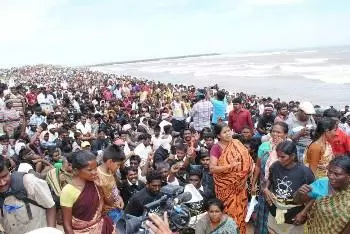A marine ecologists records the echoes of a silent revolution propelled by women

06-December-2013
Vol 4 | Issue 49
Idinthakarai is a village with a population of around 11,000 located along the southern coast of Tamil Nadu in Tirunelveli district.
The hardworking people of this small hamlet, who are dependent on the sea for their livelihood, would have continued to live their lives in anonymity and in harmony with nature had it not been for the Koodankulam Nuclear Power Plant (KKNPP) that came up barely two kilometres from their homes, severely endangering the largely untouched coastal landscape and becoming a threat to their existence.
 |
|
Women have been in the forefront of the agitation against the nuclear power plant (Photos: Antony Kebiston Fernando)
|
The plant has now been commissioned despite the spirited resistance to it mounted by the women, youth and children of this fisher community under the banner of the People's Movement Against Nuclear Energy.
What truly sets them apart from most protesters is their insistence on taking the non-violent route to garner support for their cause.
Idinthakarai has been the ground zero of some extraordinary activism but there are many untold stories connected to the people who power the movement.
It is precisely to capture these hidden realities and unheard voices of women that Anitha S, a distinguished marine ecologist, who has research experience in the Andaman and Nicobar islands, spent six months in the village in 2012.
Says the scientist, “Only a few people are aware that women like Annammal, Leela, Mary and Selvi, who are active members of the PMANE, do their daily work at sea and in their homes.
“Further, they take turns to keep vigil at the Samara Pandal erected in the 150-year old St. Lourdes church outside the KKNPP to make sure that their efforts to focus on the officially undisclosed risks associated with the production of nuclear power do not go in vain.
“This is despite the fact that some of them have been physically attacked by police and a few, like Sundari and Xavier Ammal, have been in jail on false or highly exaggerated charges.”
The point to be noted here is that these energetic women have made these efforts despite the fact that they cannot afford to miss even one day’s work, which includes catching, drying and selling fish.
Anitha has put together several poignant narratives and brought out a book, ‘NO: Echoes Koodankulam’, apart from making a short film during her stay there.
In the book, the ecologist writes about a young woman who expresses that she and the people around her have basic needs such as a secure place to live, study, work or relax, a healthy environment, safe and clean water, clothes and food.
The youngster recalls how they used to procure rice and vegetables from the relatives of one of her grandfathers, who grew these items in their fields.
However, at least 70-100 acres of that land was taken away for merely Rs 2,000 an acre or nothing for the power plant. She also talks about the cashew and tamarind trees that were sold off for a paltry Rs 100 each or absolutely free.
Today, the young woman, who rolls beedis for a living and is compelled to buy water for domestic purposes, is concerned that hot water that is likely to flow out of the nuclear power plant into the sea would kill the fish, prawns and their eggs. She adds how she misses tending to flowering plants such as the Pavizhamalli, a variety of jasmine.
According to Anitha and others who have travelled to places around the KKNPP, awareness about the drawbacks of nuclear radiation is high among the children, too.
For instance, the ecologist refers to Labisha, a girl studying in Class Nine at the Bishop Roche Higher Secondary School in Idinthakarai, who laments about the hazards of the uranium that lies inside the red and yellow domes and chimneys of the KKNPP.
“From buses plying on the Thiruchendur highway nearby, the KKNPP is a pretty structure that will help poor, illiterate fisher folk usher in progress.
“But the public hardly knows that will not be the reality for me, my younger brother Labison or my friends Shiji and Shobana, who are among the toppers in our class and enjoy watching the crabs, partridges, lapwings and terns,” shares Labisha.
While the tone in which Anitha has documented the stories is moving, the 125-page book that has been divided in three sections is not for sale, though all contributions towards the publication will be utilised to create a space with books for the kids in Idinthakarai, who are very interested in reading and writing.
 |
|
A demonstration at Idinthakarai against KKNPP
|
It’s clear that the dangers of the power plant are very real, so why then is the state insisting on producing nuclear energy when many countries are converting to clean and safe modes of power generation?
Remarks Kalpana Sharma, a respected journalist, who has visited the region, “A wind energy farm operates en route the Koodankulam Nuclear Power Plant. Yet, the government went ahead with KKNPP, ignoring natural sources of energy."
The concerns echoed by people in Idinthakarai and nearby villages, like Vairavikinar and Kootapulli are genuine and common, as per Anitha.
Further, S. P. Udayakumar, the charismatic leader of the PMANE, who has been opposing the KKNPP since its conception in the 1980s, states that the Environmental Impact Assessment, Site Evaluation Report, Safety Analysis Report and Emergency Preparedness Plan have not been disclosed to the residents of Koodankulam and its surrounding villages, or the media.
Also, the Russian firm that built the nuclear reactor has no civilian liability even if a leak, accident or other incident occurs. And one wonders how much of the power generated will reach the locals or if they would get the jobs promised.
Sadly, some of the persons in Idinthakarai faced the wrath of the tsunami in the Indian Ocean in December 2004.
According to Anitha's book, a Tsunami Rehabilitation Colony comprising around 450 homes constructed in 2006 exists within a kilometre from the nuclear power plant.
Will these lives once again experience an upheaval from a project that they have rejected? - Women's Feature Service














